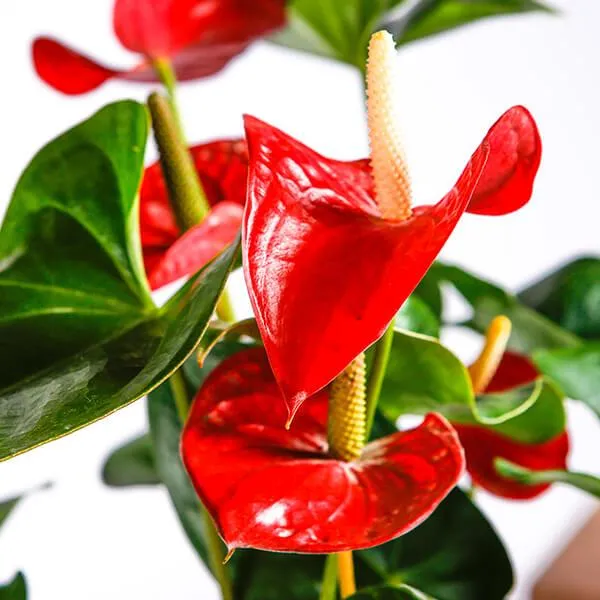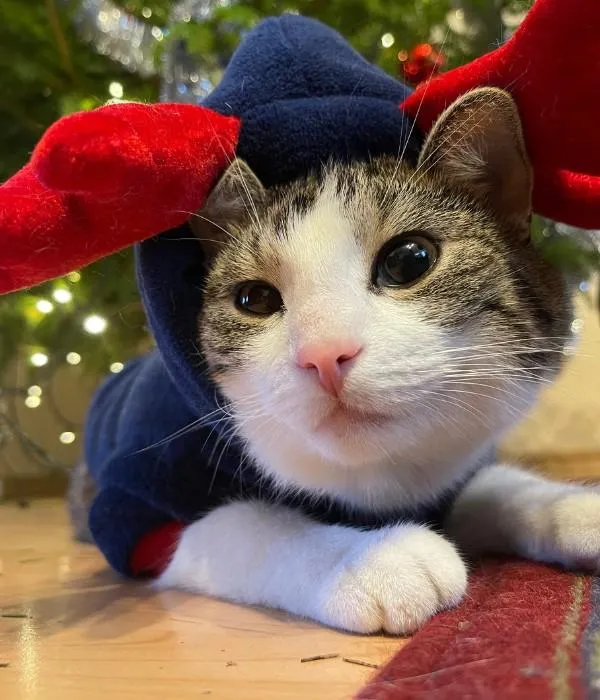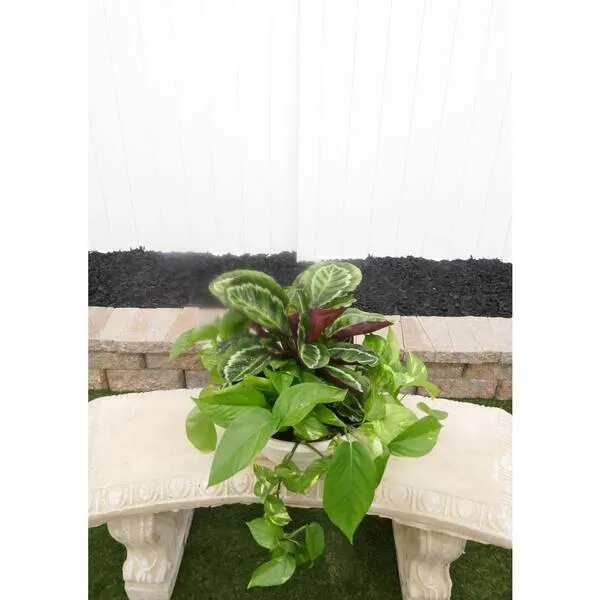Are Anthurium Plants Safe for Cats?
If you have cats and are considering introducing houseplants to your home, you may be wondering whether anthuriums are a good choice. As one of the most popular houseplants, anthuriums, also known as “tailflower” or “flamingo flower”, are eye-catching with their waxy heart-shaped leaves and large brightly colored spathes. However, their attractive appearance raises the question – are anthuriums safe for cats or could they potentially cause harm?
Potential Hazards of Anthuriums to Cats
While anthuriums are generally not considered toxic to cats, there are a few potential hazards cat owners should be aware of:
- Ingestion of leaves or spathes – If a cat chews on or ingests any part of the anthurium plant, it could cause mild gastrointestinal upset such as vomiting or diarrhea. This is because anthuriums contain needle-like calcium oxalate crystals that can irritate the mouth and digestive tract.
- Skin irritation – The calcium oxalate crystals in anthuriums can also cause minor skin irritation or discomfort if a cat comes in contact with plant sap on its nose, paws or skin. There is a small risk of swelling or reddening at the site.
- Lily effect – Though anthuriums are not true lilies, there has been at least one reported case of an anthurium causing kidney damage in cats, similar to the toxic “lily effect” some lilies can have. While rare, it’s a risk cat owners should be aware of.
In summary, while anthurium poisoning is unlikely from casual contact, there is a small potential for minor GI upset, skin irritation or even kidney toxicity if a cat ingests significant amounts of the plant.
Reducing Risks of Anthuriums for Cats
If you want to keep anthuriums as houseplants but have cat companions, there are some steps you can take to minimize any risks:
- Keep anthurium plants out of reach of cats, such as on high shelves well above cat level.
- Consider potting anthuriums in hanging baskets suspended from ceilings where cats cannot access them.
- Cover soil surfaces with decorative pebbles to discourage cats from tracking dirt and potentially ingesting soil if they scratch in plant pots.
- Monitor cats closely when first introducing anthuriums to be sure they don’t display any interest in chewing or playing with the leaves/spathes.
- Wash hands thoroughly after handling anthuriums in case any plant material transfers to a cat during petting that could then be ingested.
Taking these basic precautions can make anthuriums a relatively safe choice even with feline housemates around.

My Personal Experience
I have to be honest – from my own experience having multiple cats and anthurium plants at home, it’s been a bit of struggle to keep the plants 100% safe at times. Despite my efforts, over the years I’ve caught a curious cat chewing on an anthurium leaf here and there and scrubbing plant sap on her face while investigating. Thankfully, no negative side effects ever occurred in these situations.
The one cat I had that was especially drawn to chewing houseplants seemed to prefer spider plants and dracaenas over anthuriums. Even so, I eventually had to remove all plants from accessible areas to protect her. Now I only keep my anthuriums in a hanging basket well over her head level.
So if your cat displays an intense interest in tasting or playing with houseplants, anthuriums may not be the best choice. But for most casual feline encounters, following basic precautions has worked for me without issues.
Alternatives to Consider
If the risks of an anthurium are a concern for your cat’s safety, here are some popular low-toxicity houseplant alternatives that are generally safer:
- Spider plant (Chlorophytum comosum)- Non-toxic spikes deter chewing; great air-purifying choice.
- Peace lily (Spathiphyllum)- Toxic only if large quantities ingested; beautiful waxy leaves.
- Snake plant (Sansevieria)- Very pet-friendly with thick rigid leaves; tolerates low light.
- ZZ plant (Zamioculcas zamiifolia)- Sturdy toxic-free foliage; virtually impossible to kill!
- Pothos (Epipremnum aureum)- Cat-safe vines liven up any space; thrives on neglect.
So in summary, while anthuriums can be made reasonably safe for cats with precautions, other plant options with an even lower inherent risk level may give some owners greater peace of mind.

Final Thoughts
Hopefully this overview has helped shed some light on the safety of anthuriums for feline friends. In the end, understanding each plant’s characteristics and your individual cat’s behavior and tendencies is key. As they say – your mileage may vary!
With vigilance, prevention strategies and close monitoring when first introducing plants, many pets can coexist happily with houseplants. But keeping risks as minimal as possible is always best. So choose wisely and trust your gut when plant parenting with pets involved.
Let me know if you have any other questions! Wishing you and your furry companions the best of plant and pet harmony.
Anthurium Safety For Cats
| Plant | Toxicity Level | Possible Symptoms |
|---|---|---|
| Anthurium | Low Toxicity | Mild digestive upset if significant amount consumed |
| Vomiting or diarrhoea | ||
| Usually non-life threatening | ||
| Seek veterinary attention if symptoms persist | ||
| Keep anthurium out of reach of cats as a precaution |
FAQ
-
Is an anthurium plant dangerous for cats?
Generally speaking, anthurium plants are not considered very poisonous to cats. However, some parts could maybe cause some stomach problems if eaten. So it’s better to keep anthuriums out of reach of curious kitties just to be safe.
-
What parts of an anthurium plant should be kept away from cats?
Specifically, the berries and sap found on an anthurium can potentially bother a cat’s gut if ingested. The rest of the plant doesn’t look like it would do too much harm according to some experts, although it’s hard to say for sure as cats will cats! Best to air on the side of caution.

-
Are there any symptoms if a cat eats an anthurium?
If a kitty happens to nibble on an anthurium, it could possibly experience an upset tummy with vomiting or diarrhea. At the same time, many cats seem to show no issues at all. Keep an eye out but don’t panic – just call the vet if symptoms persist or worsen.
-
How can I cat-proof my anthurium?
To keep tabs on curious felines, put the anthurium up high out of pawing range, like on a tall shelving unit or hanging planter. You can also try those plastic spike stripsaround the pot edge as a deterrent. Maybe even consider a spray bottle filled with water to discourage any interest.
-
What’s the best plant to have around cats instead of an anthurium?
Some pet-safe greenery options are English ivy, bamboo palm, snake plant or pothos. Boneless wonders like succulents are low risk too. But, as any cat parent knows, no plant is truly “kid-proof” when it comes to those furry toast thumbs! Perhaps consider cat-friendly fake plants instead.
-
Should I get rid of my anthurium now that I have a cat?
Not necessarily – you can still keep your anthurium. However, at the same time, it’s important to thoroughly cat-proof it as described above. Also, you may wanna put it out of your new kitty’s reach for a few months until they settle in and get used to their new home. Then reintroduce the plant when the cat isn’t as curious.
-
What if my cat eats an anthurium – should I call the vet?
It couldn’t hurt to give your vet a call for advice if you catch your cat nibbling an anthurium. The vet may want to monitor kitty or provide treatment depending on how much was eaten. Even if no symptoms appear right away, it’s better safe than sorry with potentially poisonous plants. Your vet is the best person to trust for your furry friend’s wellbeing.

